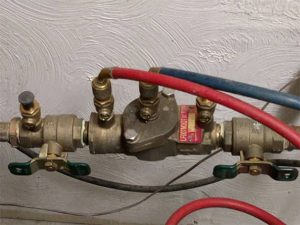Water Backflow Prevention In Auckland
With more than 15 years of experience installing and maintaining backflow valve devices to both residential and commercial buildings water supplies, Sumich Plumbing and Drainage can complete all backflow prevention jobs in Auckland to a high standard, including backflow prevention device testing, installation and maintenance.
What Is A Backflow Preventer?
A backflow preventer is a common plumbing device that is used to prevent the flow of contaminated water from entering a clean water supply. It is a device that is installed on a property’s main water pipes (where the water network system is located)

How Does A Backflow Preventer Work?
Backflow preventers operate through a series of check valves, air gaps, and other mechanical components to create a barrier that prevents backflow. At residential houses, the device is usually placed where the potable water supply joins the non-potable water supply.
Backflow preventers also stop any contaminated water going from your property water supply back into the main council water supply.
Available throughout both commercial and residential properties, they may also be installed to prevent backflow contamination between buildings on the same property, as the law requires.
High Hazard Backflow Preventer
A high hazard backflow preventer is a type of backflow preventer device that is used to water supply from toxic pollutants and contaminants that pose a health hazard to waterways and environments.
These devices are usually present in situations where the risk of water backflow is considered to be particularly high, such as in industrial settings, chemical plants, and other facilities that use hazardous materials.
Examples of high hazard situations where backflow preventers are required include facilities that handle:
- Toxic or poisonous chemicals
- Carcinogens
- Radioactive materials
- Flammable liquids
- Compressed gases
Sumich Plumbing are trained to regularly test, inspect and maintain high hazard backflow prevention devices to ensure that they are operating properly and are effectively preventing backflow.
Our Backflow Preventer Offer:
The backflow specialists at Sumich plumbing can offer your residential or commercial property:
Backflow Prevention Device Testing
Backflow prevention device testing is an important aspect of maintaining a water backflow preventer device, as it ensures that it is functioning correctly and water supply is protected.
Our testing process usually involves opening & closing the backflow device’s check valves and analysing the pressure differential across the device. We also conduct a visual inspection to see if there are any faults, air gaps, signs of wear or any other issues that can impact backflow perfomance.
Backflow Valve Installation
Backflow prevention consists of installing a backflow device, also known as a backflow preventer or water backflow preventer, which is designed to prevent the flow of contaminated water from entering a clean water supply.
The process typically will involve us making modifications to the existing backflow prevention system, such as adding more pipes or valves to facilitate the water backflow valve. Once the installation location is finalised, we will connect the backflow valve to the plumbing system and all the joints are properly sealed to prevent any leaks.
It’s paramount that this installation should only be done by a certified plumber with proper training and equipment, as they will be able to ensure that the device is installed correctly and in compliance with local regulations and industry standards.
Backflow Valve Repairs
If the backflow valve is not working properly, it may be caused by a variety of reasons, like worn out check valves, debris buildup, corrosion, leaks, or damage caused by freezing temperatures.
Water backflow repairs will be completely dependant on the specific issues which will be determined during the backflow depend on the specific problem identified during the backflow prevention testing phase.
For commercial buildings, backflow devices are required by law to be tested yearly to retain its warrant of fitness.
Frequently Asked Questions
A backflow preventer may reduce the water pressure in a plumbing system to some degree, but it depends. This is because the device is designed to create a barrier that prevents water backflow, so naturally there would be a reduction in the overall pressure. The type and size of the backflow preventer, as well as the particular circumstances in the plumbing system will all affect how much pressure is lost.
Although water pressure will decline, backflow preventers intend to minimise pressure loss as much as possible. Some backflow preventers actually come with a pressure relief valve that are able to adjust the water pressure and potentially increase the pressure.
It’s crucial to remember that any pressure loss brought on by a backflow preventer needs to be considered during installation and design. In order to make sure the device is operating correctly and to reduce any pressure loss it may cause, it is also crucial to test and maintain it on a regular basis.
The “cross-connection” location, where a potable water system links to a non-potable water supply, is where a backflow preventer is typically installed.
Here are a few places where a backlow preventer may be located:
- The point where an irrigation system connects to the potable water supply
- The point where a fire suppression system connects to the potable water supply
- The point where an industrial process connects to the potable water supply
- The point where a swimming pool or spa connects to the potable water supply
It’s important to remember that the location of the backflow preventer will be dependant on the commercial or residential property, and the condition of the plumbing system.

